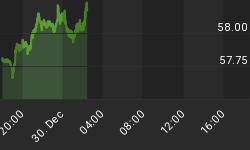PRECIOUS METALS - Since the commencement of the bull-market in precious metals, several factors (ranging from rising jewellery demand in Asia to the ongoing war in the Middle-East) have been presented by various analysts as the drivers behind the persistent appreciation in gold and silver.
In my opinion, however, the current bull-market in precious metals is primarily due to the ongoing monetary inflation (money supply and credit growth) and the subsequent debasement of various national currencies. It is important to understand that monetary inflation is the root-cause of increases in asset as well as commodity prices. During times when investors' confidence in governments and central banks is high, monetary inflation spills into financial assets causing the national currencies to lose value against stocks and bonds. On the other hand, when the investing community is suspicious of central banks and confidence in the establishment is running low, national currencies such as the US Dollar, Euro and Yen lose value against gold, silver and other tangible assets.
Since 2001, the purchasing power of the major world currencies has been diminishing against precious metals and this is a sign that at least a part of the investing public does not accept the various national currencies as a genuine store of value. Whilst it is true that the price of gold has risen by over 200% in recent years, I would argue that gold is a constant and it is in fact the US Dollar which has lost considerable value against gold due to its oversupply relative to gold.
Given the level of debt in the US, I expect inflation (money-supply and credit growth) to accelerate in the future and this should result in further US Dollar depreciation when measured in terms of gold and silver. Please note that most of the "developed" nations today are engaged in monetary inflation as they continue to devalue their currencies in order to remain competitive. As long as this insanity remains intact, I expect all the "participating" national currencies to decline further against precious metals, which will assume the role of an alternative currency. Already, we can see this taking place with the price of gold rising in relation to currencies such as the Euro, Yen and British Pound.
Although the price of gold has risen in the recent years, I suspect that we are still only halfway through this bull-market. Once the bull-market gathers steam, both gold and silver will break out to record-highs. However, in the intermediate-term, the first challenge for gold and silver is to better their highs recorded in May 2006. Once this is achieved, I believe the public will finally wake up and accept the presence of a sustainable bull-market in precious metals.
At present, the amount of capital invested in the entire precious metals universe (physical bullion as well as mining stocks) is tiny when compared to stocks and bonds. Furthermore, it is absurd to note that the market capitalization of Microsoft alone is bigger than the entire gold mining industry! So, you can only imagine what will happen to the prices of precious metals' mining stocks when capital starts to flow into this neglected sector.
Figure 1 gives the current bull-market some perspective. The grey line on the chart shows that during its previous bull-market in the 1970's, gold went up several-fold. The current bull-market in gold however is depicted by the blue line on the chart. As you can see, at current levels, the price of gold is still trading at roughly 65% below its all-time inflation-adjusted high of roughly $2,000 per ounce! In a world of inflated asset-prices, it is not very often that you can find assets selling at such depressed levels. Therefore investors are advised to allocate a reasonable portion of their wealth to gold and silver.
Figure 1: Early stages of a gold mania?
Source: BCA Research
So far in this bull-market, mining stocks of precious metals have on average outperformed physical bullion by 300%. In other words, investors who bought the mining shares made three times more money than those who bought the physical bullion. So, my advice is to invest in the un-hedged mining companies, which offer great leverage in the ongoing boom. We have invested our clients' capital in junior exploration companies as well as intermediate level producers who are about to increase their output significantly. Finally, I suggest that you avoid the large-cap mining stocks which hedge their future production as the upside from these will be limited.
The above is an excerpt from Money Matters, a monthly economic publication, which highlights extraordinary investment opportunities in all major markets. In addition to the monthly reports, subscribers also benefit from timely and concise "Email Updates", which are sent out when an important development in the capital markets warrants immediate attention. Subscribe Today!
















